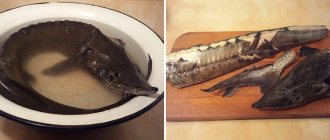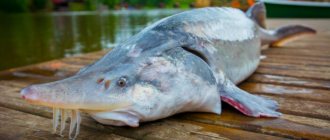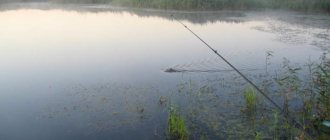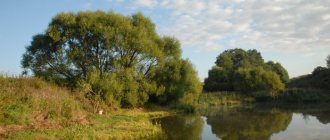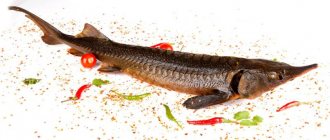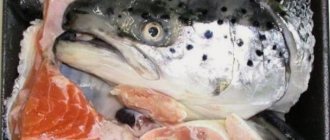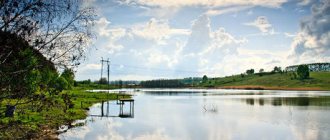Sturgeon – description, structure, characteristics, photo. What does sturgeon look like?
Sturgeon is a large fish; the body length of large species can reach 6 meters. The maximum weight of a sturgeon is 816 kg (that’s how much the world’s largest white sturgeon weighed). However, on average, commercial fish weigh 12-16 kg.
The sturgeon skeleton consists of cartilaginous tissue, there are no vertebrae, and the notochord is preserved throughout the life of the fish. The body of the sturgeon is spindle-shaped, highly elongated, devoid of scales and covered with five rows of special scutes-bugs - diamond-shaped bony scales. One row runs along the ridge, on average containing from 10 to 19 scutes, a pair of lateral rows is composed of 25-56 elements, and two rows located on the belly usually consist of 7-15 scutes (depending on the species).
Photo by: Cacophony
Each species of sturgeon is characterized by an individual number of bone bugs. Each of these elements does not merge with the neighboring one and is covered with ring-shaped stripes. Also, small star-shaped bone plates and tubercles are randomly scattered throughout the sturgeon’s body.
The pectoral fin of the sturgeon is very hard, and its spine-like front ray is especially thick and pointed. The age of a sturgeon is often determined by the transverse cut of the front ray. The dorsal fin contains from 27 to 51 rays and is noticeably set back to the tail. The rays of the caudal fin extend beyond the end of the tail and bend around it on both sides. The anal fin may contain from 18 to 33 sharp rays. The swim bladder is well developed.
Photo by: Haplochromis
The head of the sturgeon is small, the snout is elongated, cone- or spatulate-shaped, sharp or slightly blunt. At its end there are 4 antennae, usually simple, devoid of fringe (except for the sterlet, which has fringed antennae). The sturgeon's mouth is retractable and has a lower location, which is due to the peculiarity of the fish's feeding on bottom organisms. The lips are quite fleshy, the lower lip of the fish is interrupted, and there are no teeth. In fry, small teeth grow, but then disappear.
The gill openings of sturgeons are the same as those of sharks, and in the process of evolution they are transformed into squirters. On their inner surface there are simple gill rakers, the number of which varies from 24 to 45 pieces.
Photo by: Haplochromis
The color of sturgeon is predominantly gray. The back can be light gray, grayish-black or light brown, shimmering green or yellow, the fins are usually dark gray. The fish have brownish sides; the belly of the sturgeon is white, gray with blue or grayish-yellow.
Russian sturgeon
Kingdom: Animalia. Phylum: Chordata. Class: Ray-finned fish (Actinopterygii). Order: Sturgeons (Acipenseriformes). Family: Sturgeon (Acipenseridae). Genus: Sturgeon (Acipenser). Species: Russian sturgeon (Acipenser gueldenstaedtii).
Where does he live?
The Russian sturgeon lives in the basins of three seas: the Azov, Black and Caspian. On the way, it can be found in the Kama, Volga and Ural rivers. Since the early 50s. XX century The Caspian Sea basin has lost about 70% of the spawning grounds of Russian sturgeon. Due to the extensive system of dams and dams, natural spawning grounds in the Black Sea basin have almost completely disappeared. Only in the Danube and some other rivers: Samur, Dniester, Dnieper, Don, Kuban, small islands of its spawning have been preserved.
Despite its name, the Russian sturgeon is found in Georgia, Bulgaria, Azerbaijan and several other countries, and is considered extinct in Austria, Hungary and Croatia.
External signs
Russian sturgeon is a fairly large fish, the weight of which ranges from 15 to 25 kg. Sometimes heavier individuals are found, and very rarely, truly huge specimens, reaching a body length of 2.3 m and a weight of 80 kg. The fish has a powerful spindle-shaped body and a large, elongated head with a slightly pointed shape and a blunt snout at the end. At the end of the snout there are four skin processes - antennae, its tactile organ. It helps the sturgeon better navigate in space and “feel” the rocky bottom in search of suitable food. Like other members of the family, the Russian sturgeon has no bones; the skeleton consists entirely of cartilage.
The body is covered not with scales, but with bone plates - “bugs”, arranged in five stripes. Each of them starts from the base of the head and ends near the tail. This is excellent natural armor. The dorsal and anal fins, which have strong bony rays, are strongly displaced towards the caudal region. A large swim bladder helps fish feel great even at significant depths. Body color varies greatly. However, the belly is usually white, and the back and sides are grayish-brown.
Lifestyle
The Russian sturgeon leads a bottom-dwelling lifestyle, where it finds suitable food. Juveniles feed on benthic invertebrates, while older sturgeons may consume small shellfish and fish. It reaches sexual maturity at the age of no earlier than eight years. Interestingly, Russian sturgeon can freely interbreed with beluga, stellate sturgeon and sterlet, producing viable offspring. The female goes to spawn only a few times in her life, with a time interval of at least three to four years. To do this, she selects suitable rivers with a rocky or sandy bottom, with a preferred average water speed of 1.0–1.5 m/s. The female spawns, laying up to 800 eggs. After about three to four days, the fry emerge from it. Russian sturgeons are long-lived fish. Their age can reach 50 years.
Interesting fact
Currently, all species of sturgeon are under varying degrees of protection from environmental documents. Only five countries: Russia, Turkmenistan, Azerbaijan, Iran and Kazakhstan are global exporters of black caviar, the leading one being Iran. This state has a monopoly on the extraction of this most valuable product. Its violation entails severe punishment, ranging from the highest fines to... the death penalty.
In the Red Book
Over the past 45 years, the number of Russian sturgeon has decreased by 90%. This indicator in itself does not leave you indifferent! In 1996, Russian sturgeon was included in the International Red Book. Then he was assigned the protection category EN. However, there were no fundamental changes for the better. On the contrary, the situation has only worsened. Unfortunately, it is not always the case that the adoption of laws, the introduction of penalties, and the signing of international agreements can actually change the situation.
The main reason that the Russian sturgeon is on the verge of extinction today is the long-term, often uncontrolled fishing of these fish. Black caviar has been and remains a rare delicacy, the cost of which is always very high. The majority of the world's sturgeon caviar trade comes from the black market. Thus, according to the InFolio Research Group (Infolio Research Group), in 2010 alone, 225 tons of caviar from various sturgeons were produced in Russia, of which 10 tons were obtained legally. It is believed that the Russian black caviar market is 90% poached. One of the most important documents that protects the Russian sturgeon population is the Convention on International Trade in Endangered Species of Wild Fauna and Flora. It was signed by the International Union for Conservation of Nature (IUCN) in Washington in 1973. If the convention were fully implemented, the Russian sturgeon would have a much better chance of surviving in its natural habitat.
Today, the Russian sturgeon is on the verge of extinction. It is possible that soon it will no longer be found in the wild
Where does the sturgeon live?
Sturgeons can be freshwater, anadromous or semi-anadromous.
Reference: Migratory fish are fish that spend part of their lives in the sea and the other part in rivers. During spawning, they migrate from the sea to rivers or vice versa, which is less common.
Semi-anadromous fish are a group of fish that live in coastal zones of the seas (they do not go far into the sea) or in lake seas (Aral, Caspian). During spawning they migrate to the lower reaches of rivers.
The natural habitat of the sturgeon passes through the water bodies of the Northern temperate zone of Europe, northern Asia and North America.
Over millions of years of evolutionary development, the sturgeon has adapted well to living in a temperate climate zone; the fish tolerate low water temperatures well and can go hungry for a long time.
Sturgeon is a bottom-dwelling fish that swims at depths from 2 to 100 meters. Migratory species of sturgeon live in the coastal waters of seas and oceans, but their spawning occurs only in fresh river water, where the fish enter by swimming against the current and travel considerable distances. At the end of spawning, schools of fish go back to the sea. Semi-anadromous species of sturgeon live in the salty coastal waters of the seas and oceans and make spawning migrations to river mouths without going upstream. Most freshwater sturgeon species are not subject to long migrations, but lead a sedentary lifestyle in the waters of rivers and lakes, where they feed and reproduce.
Photo by: Engbretson Eric
Sturgeon spawning, reproduction and offspring
These aquatic inhabitants spawn in April, swimming into rivers with strong currents, at a depth of up to 20 m, where the water temperature ranges from 15 to 20 C. Sturgeon is a prolific fish, laying more than a million eggs at the bottom of reservoirs between stones. Fertilized eggs have a sticky shell and stick to the pebbles for 90 hours. Small individuals feed on zooplankton and live in fresh water for about a year. According to some studies, young animals live in their birth areas for 2-3 years, then move to the seas. The fry die in salt water.
What does sturgeon eat?
Sturgeon feed on a variety of bottom organisms and fish, and the composition of the diet depends on the age of the fish and the specific habitat. The diet of an adult sturgeon consists of 85% protein food; the fish become especially voracious before spawning: they eat almost everything they can find on the bottom. These can be various crustaceans, mainly amphipods (ambipods or amphipods) and representatives of the order Cladocera. Insect larvae, mosquito larvae and caddis flies are eaten in large quantities, as well as mollusks, shrimp, mussels, worms and leeches. If the amount of protein food is limited, sturgeons eat algae. The fish diet includes sand lance, anchovies, herring, sprat, sprat, gobies, silver bream, pike perch, mullet and other small and medium-sized fish. Cases have been recorded of large sturgeons successfully hunting wild ducks.
Sturgeon fry feed primarily on zooplankton (daphnia, cyclops and bosmina), but are capable of eating very small crustaceans and worms. Juveniles eat insect larvae, snails, small shrimp and crustaceans. In the stomachs of the fry, many inedible particles are often found, probably absorbed from the muddy deposits.
During the breeding season and after spawning, the sturgeon practically stops eating or switches to a plant diet, but within a month the fish’s appetite is restored, and they go back to fattening.
Sturgeon nutrition
At a length of 20 mm, young individuals switch to active feeding, first consuming zooplankton, then zoobenthos. Larger juveniles (5-6 cm) eat the same crustaceans 11-13 mm long. In juvenile sturgeon measuring 9-10 cm, mysids up to 22 mm long are found in the stomachs. Single specimens, reaching 6-7 cm, swallow fish larvae (mainly gobies and gudgeons) 10-11 mm long. The main food of fingerlings up to 30 cm in length are crustaceans, mainly amphipods. A significant part of the diet of sturgeon, 30-40 cm long, consists of worms and gobies.
The diet of large-sized sturgeon (60-170 cm) varies according to seasons, years and habitat. In the Black Sea, sturgeon feeds mainly on mollusks, crustaceans, and in small quantities on fish. About three quarters of commercial sturgeon in the middle Volga have empty stomachs. In the Caspian Sea, sturgeon feed mainly on small fish - gobies and sprat; Of secondary importance are molluscs, crustaceans, chironomid larvae and worms. In the spring, the sturgeon of the northern Caspian feeds mainly on fish, and in the summer on crustaceans.
Classification of sturgeon
According to the fishbase.org database, there are 17 species of sturgeon (data from 10/2016):
- Acipenser baerii – Siberian sturgeon;
- Acipenser brevirostrum – Blunt sturgeon;
- Acipenser dabryanus - Korean sturgeon;
- Acipenser fulvescens - Lake sturgeon;
- Acipenser gueldenstaedtii - Russian sturgeon;
- Acipenser medirostris - Green sturgeon (Pacific);
- Acipenser mikadoi - Sakhalin sturgeon;
- Acipenser naccarii - Adriatic sturgeon;
- Acipenser nudiventris - Thorn;
- Acipenser oxyrinchus - American Atlantic sturgeon;
- Acipenser persicus - Persian sturgeon;
- Acipenser ruthenus - Sterlet;
- Acipenser schrenckii - Amur sturgeon;
- Acipenser sinensis - Chinese sturgeon;
- Acipenser stellatus - Stellate sturgeon;
- Acipenser sturio - Atlantic sturgeon;
- Acipenser transmontanus - White sturgeon.
Fossil species of sturgeon:
- Acipenser albertensis † - Campanian stage of the Upper Cretaceous - early Paleocene 83.5-61.7 million years ago
- Acipenser eruciferus † - Campanian - Maastrichtian stages of the Upper Cretaceous 83.5-65.5 million years ago
- Acipenser molassicus†
- Acipenser ornatus†
- Acipenser toliapicus † - Lutetian stage of the Eocene 48.6-40.4 million years ago, Europe and northern Asia
- Acipenser tuberculosus†
Types of sturgeon, photos and names
The sturgeon genus includes 17 species of fish, most of which are listed in the Red Book with the status of critically endangered. Below is a description of some types.
- Siberian sturgeon ( Acipenser baerii)
Large fish up to 2 meters long. Sturgeon weighs up to 210 kg. Within the species, there are 2 varieties: sharp-snouted and blunt-snouted (regular) individuals. The general population of Siberian sturgeon is divided into freshwater and semi-anadromous forms, which inhabit the Siberian rivers from the Ob to the Kolyma, and also live in Lake Baikal and in eastern Kazakhstan in Lake Zaisan. Initially, the Siberian sturgeon species was divided into 4 subspecies:
- Yakut sturgeon sturgeon (lat. Acipenser baerii chatys, Drjagin, 1948), called khatys, which lives in Khatanga, Lena, Yana and Indigirka,
- Baikal sturgeon (lat. Acipenser baerii baicalensis, Nikolskii, 1896), inhabiting Lake Baikal and having a similar morphology to the North American sturgeon,
- East Siberian (long-snouted) sturgeon (lat. Acipenser baerii stenorrhynchus, Nikolskii, 1896);
- West Siberian sturgeon (lat. Acipenser baerii baerii, Brandt, 1869).
At the end of the 20th century, scientists proved that there are no significant differences between these subspecies, and the division became unacceptable. The diet of the Siberian sturgeon includes amphipods, insect larvae (mainly caddis flies and mosquitoes), as well as mollusks and various types of small fish, especially juvenile Baikal lobster. The Siberian sturgeon interbreeds freely with the Siberian sterlet, and their offspring are called koster. The Siberian sturgeon differs from the sterlet in the smaller number of lateral bugs (up to 50). The difference from the Russian sturgeon is that the Siberian species has fan-shaped gill rakers and a sharper snout in some individuals.
Taken from the site: www.rybarskyrozcestnik.cz
- White sturgeon (Acipenser transmontanus)
A very large species of sturgeon, second in size only to beluga and kaluga, and also the largest North American fish. Conservation status: Least Concern. The unofficial name of the fish is California white sturgeon. The fish has a fairly slender body, and the length of the largest sturgeon was 6.1 m with a mass of 816 kg, although the average weight of a sturgeon usually does not exceed 10-20 kg. The dorsal row contains from 11 to 14 scutes, the lateral rows consist of 38-48, the ventral scutes range from 9 to 12. The back and lateral surfaces are painted in grayish, light olive or grayish-brown shades, the belly and underside of the head are white. The sturgeon feeds on numerous mollusks, various crustaceans, lampreys and fish, including smelt. The white sturgeon is an anadromous fish that lives in the Pacific waters off the western coast of North America from the Aleutian Islands, located in the subarctic zone, to the state of California. Spawning grounds are located in brackish river mouths; some individuals migrate far up into fresh waters. Regular migrations into rivers for these fish are not necessarily associated with spawning. The most numerous populations of California sturgeon are found off the coast and in inland waters of Washington and Oregon states, southwest Alaska, California's San Francisco Bay, and the deltas of the Sacramento and San Joaquin rivers. Dams built on the Columbia and Snake rivers isolated part of the population in the river, and over time the fish acquired a freshwater form.
Photo by: Wald1siedel
- Russian sturgeon (Acipenser gueldenstaedtii)
One of the very first artificial breeding facilities, which is highly valued throughout the world for the exceptional gastronomic qualities of meat and caviar. Conservation status: critically endangered. It has a walk-through and residential form. The Russian sturgeon differs from other sturgeons by its blunt, short snout and antennae, which grow not near the mouth, but closer to the end of the snout. The maximum length of an adult Russian sturgeon is 2.36 m with a weight of 115 kg, but usually the weight of the sturgeon does not exceed 12-24 kg. The average length is 1.45 m. The Russian sturgeon has a grayish-brown back, gray sides with a yellow tint and a whitish belly. The dorsal row usually contains from 9 to 18 bugs, the lateral rows from 30 to 50, and the ventral rows no more than 7-12. Depending on the habitat, the diet of representatives of the species consists of amphipods (amphipods), mysids and worms. The fish diet includes sprat, herring, mullet and shemaya. Under natural conditions, Russian sturgeon produces hybrid offspring with beluga, sterlet, stellate sturgeon and thorn. Russian sturgeon is found in almost all major waterways of Russia. The main habitat of sturgeon is the basins of the Caspian, Black and Azov seas. Russian sturgeon goes to spawn in the Volga, Terek, Don, Kuban, Samur, Dnieper, Danube, Rioni, Mzymta, Psou and other rivers.
Photo by: Martin Chytry
- Amur sturgeon , also known as Schrenck's sturgeon (Acipenser schrenckii, Acipenser multiscutatus)
It forms freshwater (residential) and semi-anadromous forms, which are considered close relatives of the Siberian sturgeon. But, unlike the Siberian sturgeon, the gill rakers of the Amur species are not fan-shaped, but smooth and have one apex. Conservation status: critically endangered. The Amur sturgeon reaches 3 meters in length with a body weight of about 190 kg, but the average weight of a sturgeon usually does not exceed 56-80 kg. Representatives of the species have a pointed, elongated snout, which can be up to half the length of the head. The dorsal rows of the sturgeon contain from 11 to 17 bugs, the lateral rows from 32 to 47, the abdominal rows from 7 to 14. Amur sturgeons eat caddis and mayfly larvae, various crustaceans, lamprey larvae and small fish. The sturgeon lives in the Amur River basin, from the lower reaches and above, to Shilka and Argun; during the breeding season, schools go up the river to the Nikolaevsk-on-Amur region.
Photo by: Elena Lukina
- Atlantic sturgeon (Acipenser sturio)
A very large representative of the genus, the maximum size of which can reach 6 meters. The maximum recorded weight of the fish is 400 kg. The bugs of the Atlantic sturgeon are much larger than those of other sturgeons, and on the tail there are 3 pairs of large fused scutes. On the back of the sturgeon, oblique rows of small diamond-shaped plaques and from 9 to 16 large light bugs are clearly visible. The lateral rows contain from 24 to 40 scutes, on the belly from 8 to 14. The back of the fish is grayish-olive in color, the sides are much lighter, the belly is white. Sturgeon food includes small fish (anchovies, capelin and sand lance), as well as worms, crustaceans and mollusks. Initially, the Atlantic sturgeon was found off the coast of Europe in the Baltic, North, Mediterranean and Black Seas, as well as off the North American coast from Hudson Bay to South Carolina. Schools of fish went to spawn in the rivers Svir, Volkhov, Elbe, Oder, and Danube. Despite its impressive historical range, the Atlantic sturgeon is critically endangered and has been virtually extirpated in most areas. Currently, the Atlantic sturgeon is found only in the Black Sea and the Bay of Biscay, where no more than 300 individuals live. According to foreign sources, a small number of Atlantic sturgeon are found only in the Garonne River in France.
Taken from: itsnature.org
- Lake sturgeon (Acipenser fulvescens)
A large representative of the genus, biologically close to the blunt-nosed sturgeon. The maximum recorded length of adult fish is 2.74 m with a body weight of 125 kg. The body is colored black with gray or greenish-brown, the belly is white or yellowish. Basically, lake sturgeon feed on all kinds of bottom organisms; fish is consumed to a lesser extent. The lake sturgeon is a North American and Canadian resident found in the Great Lakes system, Lake Winnipeg, and the Mississippi, Saskatchewan, and St. Lawrence river basins. Conservation status: Least Concern.
Photo credit: Fungus Guy
- Sakhalin sturgeon (Acipenser mikadoi)
The rarest and rather poorly studied species, biologically identical to the green (Pacific) sturgeon. The average length of adult specimens reaches 1.5-1.7 m with a weight of 35-45 kg, the largest individuals grow up to 2 m in length and weigh about 60 kg. Adults have a large, blunt snout. The color of the Sakhalin sturgeon is greenish-olive, there are from 8 to 10 bugs on the back, from 27 to 31 on the sides, from 6 to 8 on the belly. The food of the Sakhalin sturgeon consists of various inhabitants of the muddy bottom: snails and other mollusks, insect larvae, small shrimp, crustaceans, and small fish. The species' range covers the cold waters of the Sea of Japan, the Sea of Okhotsk and the Strait of Tatar; the fish goes to the Tumnin River in the Khabarovsk Territory to spawn.
Taken from the site: www.ichthyo.ru
- Persian sturgeon , also known as South Caspian or Kura sturgeon (Acipenser persicus)
An anadromous species, a close relative of the Russian sturgeon. It is on the verge of extinction. The maximum size of a sturgeon is 2.42 m and weighs 70 kg. Representatives of the species have a large, long, slightly curved snout and a gray-blue back, blue sides with a metallic tint. The Persian sturgeon also differs from other species in having fewer bugs in each row. The diet of the South Caspian sturgeon consists mainly of benthos and small fish. The natural habitat of the fish is the middle and southern regions of the Caspian Sea; a small proportion of the population inhabits the northern regions of the Caspian Sea and is found along the Black Sea coast. The main spawning grounds are located in the Volga, Ural, Kura, Inguri and Rioni rivers.
Photo by: Dorafshan, S.
- Sterlet (Acipenser ruthenus)
The medium-sized representative of the sturgeon genus differs from other sturgeons in its early sexual maturation: males are ready for reproduction at the age of 4-5 years, females at 7-8 years. Another difference between the sterlet and other sturgeons is its fringed antennae and a large number of lateral bugs: usually more than 50. Sterlet is a freshwater fish, but there are a small number of semi-anadromous forms. The maximum length of a sterlet reaches 1.25 m, and its weight does not exceed 16 kg. The average size is 40-60 cm. Sterlet can be sharp-snouted or blunt-snouted, and its color varies from brown with gray to brown, its belly is white with yellowish tint. Most of the sterlet's diet consists of insect larvae, leeches and other benthic organisms; fish is eaten to a lesser extent. A valuable hybrid form of sterlet and beluga, bester, is a popular object of economic cultivation. The natural habitat of the sterlet is in the rivers of the Caspian, Black, Azov and Baltic seas, found in rivers such as the Dnieper, Don, Yenisei, Ob, Irtysh, Volga with its tributaries, Kuban, Sura, Ural, upper and middle Kama, formerly also found in Lakes Ladoga and Onega. Some of the population was moved to the Neman, Western Dvina, Pechora, Onega, Amur, Mezen, Oka and a number of artificial reservoirs, although the fish did not take root everywhere. Conservation status: vulnerable species.
Photo by: weisserstier
- Stellate sturgeon (Acipenser stellatus)
An anadromous species of sturgeon, closely related to the sterlet and sturgeon. Sevruga is a large fish, reaching a length of 2.2 m and weighing about 80 kg. The stellate sturgeon has an elongated, narrow, slightly flattened snout, accounting for up to 65% of the length of the head. The rows of dorsal bugs contain from 11 to 14 elements, in the lateral rows there are from 30 to 36, on the belly from 10 to 11. The surface of the back is black-brown in color, the sides are much lighter, the belly is usually white. The diet of the stellate sturgeon consists of crustaceans and mysids, various worms, as well as small species of fish. Stellate sturgeon lives in the basins of the Caspian, Azov and Black seas; sometimes fish are found in the Adriatic and Aegean seas. During the breeding season, the sturgeon goes to the Volga, Ural, Kura, Kuban, Don, Dnieper, Southern Bug, Inguri and Kodori.
Photo by: Lubomír Klátil
Types of sturgeon
In Russia, sturgeon live in places from the White Sea to the Caspian Sea. Fish are found in the basins of Siberian rivers, in the east - in the Pacific Ocean, in the west, sometimes in the Baltic Sea.
Amursky
It is found in the basins of the Amur River, including in floodplain lakes: Kizi, Boloni, Orel-Chle. The Amur sturgeon is distinguished by the presence of smooth gill rakers with 1 apex. An endangered species. The length of the Amur sturgeon reaches 3 meters and weighs about 190 kilograms, the average weight does not exceed 56-80 kilos.
Representatives of sturgeon are distinguished by their pointed, elongated snout. The fish feeds on larvae of mayflies, caddis flies, lampreys, various crustaceans, and small fish. During the spawning period, schools of fish go up the river to the Nikolaevsk-on-Amur region.
Kaluga
A fish belonging to the beluga genus. It is a large fish, the length of which reaches more than 4 meters and weighs up to 1000 kilograms. Kaluga is considered a long-liver, because with a weight of about 600 kilograms it can live up to 50 years. The diet includes fish: pink salmon, silver carp, carp, chum salmon. Small individuals feed on minnows and lampreys. Puberty occurs late - by 18-20 years.
Inhabits the Amur basin along its entire length. Found in Lake Orel, Ussuri. Does not go into the Sea of Okhotsk.
Atlantic (Baltic)
A large fish, the length of which can reach 6 meters. The maximum recorded weight of the fish is 400 kilograms. The Atlantic sturgeon has large bugs and has three pairs of large fused scutes on its tail. The back color of the Atlantic sturgeon is grayish-olive, the sides are lighter than the back, and the belly is white.
The habitat is the Black Sea and the Bay of Biscay, where no more than 300 individuals are found. A small number of fish are found only in France in the Garonne River.
The Atlantic sturgeon prefers to feed on small fish (gerbil, capelin, anchovies), worms, crustaceans and mollusks.
Stellate sturgeon
A large fish, the length of which reaches 2.2 meters and weighs about 80 kilograms. It is characterized by an elongated, narrow, slightly flattened snout. The back of the sturgeon is black-brown, the belly is white, the sides are lighter than the back.
Stellate sturgeon prefers to feast on mysids, crustaceans, various worms and small fish. The stellate sturgeon lives in the basins of the Black, Azov, and Caspian seas. During the spawning period, the fish goes to Kodori, Volga, Inguri, Ural, Southern Bug, Kura, Dnieper, Kuban, Don.
Sterlet
The natural habitat of the sterlet is the rivers of the Baltic, Black, and Azov seas. Fish is found in the following rivers: Ural, Dnieper, Sura, upper and middle Kama, Yenisei, Irtysh, Ob, Volga, Don. Previously, sterlet was found in Lakes Onega and Lake Ladoga. The fish is considered a vulnerable species.
Sterlet is a medium-sized fish. Puberty occurs early: males are ready for spawning at the age of 4-5 years, females - at 7-8 years. Another difference between the sterlet and other sturgeons is the presence of fringed antennae and a large number of lateral bugs: there are more than 50 of them.
Sterlet is a freshwater fish, but there are few semi-anadromous forms. The maximum length of the sturgeon variety reaches 1.25 meters and weighs 16 kilograms. The average size of a sterlet is 40-60 centimeters. The snout of the fish is sharp or blunt, the color varies from brownish-gray to brown. The belly is white with yellowish tint.
Sterlet feeds on insect larvae, leeches, other bottom organisms, and small fish in small quantities. A valuable hybrid form of sterlet and beluga is bester.
Read about breeding sterlet at home here.
Thorn
The advantage of the sturgeon is that it thrives equally well in both fresh and salt water, due to which its habitat extends over many kilometers. Representatives of this species are found in the Black, Caspian, Azov, Aral Seas, and in river basins adjacent to these reservoirs. Many individuals live in the Sefidrud River, the Urals, and the Kura.
Adult spiny fish can reach more than 2 meters in length, but many representatives of this species are smaller. The spine is characterized by an elongated body with cone-shaped spines on the back. Unlike other representatives of sturgeon, the sturgeon has fringed antennae located near the lower lip.
The color of the thorn varies from light gray to greenish, the belly is light. There are star-shaped scales on the surface. Thorn is a fish listed in the Red Book of Russia.
Ozerny
The lake sturgeon is a large fish with a blunt snout. The maximum size officially registered is 2.74 meters with a weight of 125 kilograms. The sturgeon's body color can be greenish-brown, black with a gray tint. The belly is white or slightly yellow.
The diet of the lake sturgeon includes all kinds of bottom microorganisms; the sturgeon feeds less often on fish. The fish's habitat is the Great Lakes system, Lake Winnipeg, and the basins of the Saskatchewan, Mississippi, and St. Lawrence rivers.
Russian (Caspian-Black Sea)
A valuable species of sturgeon, which has gained popularity due to the exceptional gastronomic qualities of its meat and caviar. An endangered species. The fish has a blunt, short snout and antennae growing towards the end of the snout. The maximum length of an adult reaches about 2.36 meters and weighs 115 kilograms. But usually the weight of Russian sturgeon is 12-24 kilograms with an average length of 1.45 meters. The color of the back is grayish-brownish, the sides are with a yellow tint, and the belly is white.
The Russian sturgeon lives in all major water areas of Russia. Found in the basins of the Caspian, Azov and Black Seas. During the spawning period, fish go to the Mzymta, Psou, Volga, Rioni, Terek, Danube, Don, Dnieper, Kuban, Samur and other rivers.
Depending on the habitat, the diet of representatives consists of worms, mysids and amphipods. Russian sturgeon prefers to eat fish: shemaya, mullet, herring, sprat. Under natural conditions, the sturgeon produces hybrid offspring with thorn, stellate sturgeon, sterlet and beluga.
Persian (South Caspian)
The Persian sturgeon is an anadromous species that is a close relative of the Russian sturgeon. Conservation status: critically endangered. The maximum size of a sturgeon is 2.42 meters and weighs 70 kilograms. Representatives are characterized by a large, long, slightly curved snout and a gray-blue back, blue sides with a metallic tint.
The fish's diet consists of benthos and small fish. Sturgeon is found in the middle and southern regions of the Caspian Sea, areas of the Caspian Sea and off the Black Sea coast. During spawning they go to the Rioni, Volga, Enguri, Ural, Kura.
Beluga
A large fish, the weight of which can reach 1500 kilograms and a length of more than 4 meters. The fish's snout is similar in appearance to that of a pig. The mouth is large, sickle-shaped, the lips are thick. The eyes are small and blind. The body is covered with large scales. The back is grayish-brown in color, the belly is light, almost white.
Beluga lives in the Black, Azov and Caspian seas. Rarely found in the Adriatic Sea. It goes to spawning in the Dniester, Volga, Dnieper, Don, and Danube. Slightly less common in the Terek, Ural or Kura rivers.
Beluga fry feed on river plankton, caddis and mayfly larvae, eggs and fry of other fish. Having matured, the fish eat juvenile sturgeon and stellate sturgeon, crustaceans, mollusks, gobies or sprat, carp and herring.
Sakhalin
A rare species of sturgeon. The average length of adult individuals reaches 1.5-1.7 meters and weighs 35-45 kilograms. The largest individuals can reach up to 2 meters and weigh about 60 kilograms. Adult Sakhalin sturgeons have a large, blunt snout and a greenish-olive color.
Sturgeons feed on various bottom inhabitants: snails, insect larvae, small shrimp, mollusks, crustaceans, and small fish.
The habitat covers the cold waters of the Seas of Japan and Okhotsk, the Tatar Strait. The sturgeon goes to spawn in the Tumnin River, located in the Khabarovsk Territory.
Sturgeon spawning
With the exception of certain species, sexual maturation in sturgeon occurs quite late: males are ready to breed at the age of 5 to 18 years, females mature at the age of 8 to 21 years. The time of maturation depends on the habitat: the further north the fish live, the later they are ready for reproduction. Reproduction does not occur every year. Spawning of female sturgeon occurs once every 3-5 years, males spawn more often. After reproduction (spawning), the sturgeon does not die, unlike some other fish species.
The spawning migration of anadromous and semi-anadromous sturgeon species is significantly extended in time and lasts from early spring to November, and its peak occurs in mid-summer. Early migrating sturgeon (spring species) spawn in the same year, winter forms of sturgeon overwinter in rivers and spawn the following spring.
For spawning, sturgeon choose rivers with strong currents (up to 1-1.5 m/sec) and a rocky or pebble bottom, less often sandy. Reproduction is not observed in salty or stagnant water. Spawning occurs at a depth of 4 to 25 m at a water temperature of + 15 to +20 degrees, depending on the habitat. An increase in temperature negatively affects the development of embryos, significantly reducing the number of hatched larvae, and at water temperatures above 22 degrees, sturgeon caviar dies.
Spawning occurs in bottom crevices or cracks of large stones, sometimes in well-turfed areas of the banks, flooded by spring floods. Sturgeon is one of the most prolific fish: large females are capable of laying up to several million eggs, accounting for about 25% of their body weight. The largest caviar is that of the Pacific (green) sturgeon, reaching a diameter of 4.5 mm, and the average diameter of the eggs is 2-3 mm. Moreover, 1 g of sturgeon caviar contains about 100 eggs.
Taken from the site: salmanayashi.id
Sturgeon caviar is sticky and adheres well to the substrate where it was deposited. At a water temperature of about +20 degrees, embryonic development lasts approximately 2-4 days. The incubation period can last up to 10 days. The weight of hatched larvae is about 10 g with a length of 0.8-1.1 cm.
Newborn sturgeons have poor vision and poor swimmers, so at first they hide in shelters under stones.
Photo by: Martin Chytry
The large yolk sac that surrounds the sturgeon larva and serves as food for it completely dissolves in 10-14 days. During this time, the fry grow to 1.6-2 cm and begin active feeding: they usually eat planktonic crustaceans (daphnia, cyclops), and then switch to mysids, gammarids, oligochids and chironomid larvae. Now the sturgeon fry acquire the features of adults and swim quite well. Juveniles of migratory sturgeon species swim to the pre-estuary space of the river, where they live for some time. The fry of some species (thorn, Russian sturgeon) linger in fresh river water, where they live for a year and sometimes a little longer. Thus, the first year of life of sturgeon fry is spent in fresh water or at the border of fresh and salt water, since concentrated salt water of the seas is destructive for young sturgeons.
Selected species
The sturgeon genus includes about 19 individual species, many of which are currently on the verge of extinction, which has been facilitated by both active fishing (sturgeon caviar and meat are highly expensive), and pollution, as well as regulation of rivers in which sturgeon spawning usually occurs. Most fish are anadromous or semi-anadromous, with quite average dimensions, but there are also real giants; the maximum weight of trophy specimens, as in the case of white sturgeon, can exceed 800 kilograms.
The sturgeon genus is quite numerous, numbering about 19 species, and some of them may well interbreed, also producing valuable hybrids.
Stellate sturgeon
This representative of the sturgeon family has quite average dimensions: up to 2.2 meters in length and weighing up to 80 kilograms. Like most sturgeons, it is distributed primarily in the basins of the Black, Azov and Caspian seas, but occasionally the sturgeon is also found in the Adriatic and Aegean seas. Attempts were made to populate the Aral Sea with this fish, but it was not possible to create a stable population.
When going to spawn, sturgeon can be found in rivers such as the Volga, Ural, Terek, Samur, Sulak, Dnieper, Southern Bug, Rioni, Danube, Don, Kuban. However, due to the regulation of most rivers, their pollution by domestic and agricultural runoff, as well as uncontrolled fishing, the population of stellate sturgeon has declined everywhere, and the species has a status on the verge of extinction. Natural reproduction of the species is not enough; a number of fish factories raise juvenile stellate sturgeon specifically in order to later release the fish into the rivers where they are usually found to maintain the population size.
Russian sturgeon
This representative of the genus can form both an anadromous and residential form. It lives in the basins of the Black, Caspian and Azov seas, but Russian sturgeon are also periodically encountered in rivers such as the Kama, Volga, and Ural. This species can spawn in the Ural, Volga, Terek, Don, Danube, Dnieper, Kuban and some other rivers.
The Russian sturgeon can live up to 46 years, reaching a maximum weight of 115 kilograms and a body length of 2.36 meters. However, the average size of the fish is still more modest - usually 12–25 kilograms. These sturgeons reach sexual maturity quite late, for males: from 8 to 13 years, for females from 8 to 20 years, which to some extent contributes to the decline in the population, as well as difficulties with spawning, which are caused by the regulation of rivers in which they usually reproduction occurs.
Like all representatives of the genus, the Russian sturgeon feeds from the bottom, consuming mainly a variety of crustaceans, worms, insect larvae, and only occasionally attacks other fish.
Thorn
In nature, this representative of the sturgeon family is protected, since its numbers have decreased so much for a number of reasons that the species is currently considered to be on the verge of extinction. The sizes are rather average - body length up to 2 meters and weight up to 30 kilograms. This fish lives up to 30 years. It inhabits mainly the basins of the Caspian and Aral Seas; it was previously found in the Black and Azov Seas, but today it is not found practically anywhere: in the Aral Sea basin the thorn disappeared after this reservoir began to dry out.
The fish is semi-anadromous; its spines remain in rivers for the winter. They feed mainly on a variety of mollusks and worms; fingerlings eat mainly a variety of crustaceans and amphipods.
White sturgeon
This species lives along the west coast of the United States of America, it can be found from the Aleutian Islands to the coast of California, however, according to local fishermen, the population of this fish is especially large in the Vancouver area. The white sturgeon is one of the largest representatives of the genus; the body length of the fish can exceed 6 meters and weight – 800 kilograms. Unlike sturgeons common in the Russian Federation and neighboring states, the white sturgeon is in the least threatened. The numbers are quite stable; there is no decline in the population of this fish. In Canada there are companies that organize trophy tours for the extraction of this particular type of fish.
Sterlet
A relatively small species in this genus of fish, which also reaches sexual maturity earlier than others: in sterlet, males go to their first spawning at the age of about 4–5 years, females when they reach 7–8 years. Body length up to 1.2 meters and weight up to 16 kilograms. Such fish can live up to 30 years.
The largest sterlet
Despite the vulnerable position of the species, sterlet is quite widespread in water bodies in the middle zone. Inhabits the basins of the Black, Azov and Caspian seas. Along the rivers, this fish is found in the waters of the Dnieper, Ob, Yenisei, Don, Ural, Kama, Kuban, Vyatka, Don, but often these are single individuals.
The number of this species has been negatively affected by massive poaching, environmental pollution by both domestic and agricultural waste (sterlet is extremely sensitive to any type of water pollution, as well as the concentration of dissolved oxygen in it), and the regulation of water bodies is also a significant problem. The presence of dams on the river prevents fish from rising to the upper reaches, where spawning will be most effective. They are trying to maintain the sterlet population in every possible way, mainly through cultivation in artificial conditions.
Many representatives of the species lead a relatively sedentary lifestyle and do not leave the river in which they live. They overwinter in deep holes, remaining practically motionless until the spring warms up.
Dams become an insurmountable obstacle for sturgeon going to spawn. The places where the eggs had the greatest chance of successful development become inaccessible, spawning is ineffective, as a result of which, against the backdrop of intensive fishing, the number of fish is sharply reduced.
Siberian
As the name suggests, this species inhabits the rivers of Siberia. It reaches a length of up to 2 meters and a weight of up to 200 kilograms. The lifespan of this fish can reach up to 60 years. The Siberian sturgeon grows slowly, this applies to both gaining weight and body length, and reaching sexual maturity: in the Ob basin, the fish go to spawn after 9 years of life, for the population found in the Yenisei this period is even longer: here individuals go to spawn after 18 years of life. Siberian sturgeon is found in rivers such as the Ob, Lena, Yenisei, Kolyma, Pechora and many others. Some experts tend to classify the fish found in the reservoirs of eastern Siberia as a separate subspecies - khatys, or Yakut sturgeon. And the sturgeon that lives in Lake Baikal is also somewhat different, which is in many ways similar to the lake sturgeon found on the American continent.
How long does sturgeon grow?
Sturgeon grows quite slowly: large species of sturgeon at the age of 2 years grow only to 28-35 cm in length, by 4 years the growth doubles. At the age of 8, the sturgeon has a body length of about 1 m, and only by the age of 12 does it reach the average size for the species.
Photo credit: US Fish and Wildlife Service Southeast Region
Sturgeon - benefits and harm
The calorie content of sturgeon is 160 Kcal per 100 g.
Sturgeon contains easily digestible proteins, due to which the product is very quickly digested and is often included in various diets. The composition of sturgeon meat is rich in rare beneficial acids, including glutamic acid, as well as vitamins B, C, A and PP. Delicious sturgeon meat contains a lot of useful macro- and microelements: potassium, phosphorus, calcium, magnesium, sodium, chlorine, iron, chromium, molybdenum, nickel, iodine and fluorine.
Sturgeon caviar is saturated with healthy proteins and lipids, and its calorie content is about 200 Kcal, so the product is recommended for use by people who are weakened after a serious illness and have undergone aggressive treatment.
Regular consumption of sturgeon meat, which contains healthy fatty acids, has a beneficial effect on blood vessels and heart muscle, lowering blood cholesterol levels and reducing the risk of myocardial infarction. The product has a positive effect on the growth and strengthening of bone tissue, and also promotes skin regeneration.
Fishing
At the beginning of the 20th century, sturgeon fishing in Russia was on a grandiose scale, and the amount of fish caught was greater than in all countries of the world combined. Therefore, despite the extreme fertility of sturgeon, the population has declined catastrophically and since the beginning of the 21st century, fishing for almost all types of sturgeon has been completely prohibited in Russia.
Taken from the site: homed.us
Interesting facts about sturgeon
- Sturgeon fish is one of the oldest and most sought after fish on earth. Archaeological finds dating back to 3 thousand years BC. e. showed that sturgeon caviar was already successfully used in canned form by sailors in those days. In the army of Alexander the Great, sturgeon caviar was used as food for soldiers.
- In the middle of the 20th century, an Atlantic sturgeon weighing 213 kg was caught in the Neva, from which 80 kg of caviar was obtained.
- In the last century, one observant French woman noticed that the hands of women working in sturgeon caviar processing plants, despite their hard work, remain beautiful and smooth. Then the miraculous properties of black caviar were urgently studied and a line of cosmetics was launched, which enjoyed incredible success. Currently, the production of such cosmetics has been suspended due to its unprofitability.
Photo by: Klaus Rudloff
Did you like the article? Share with your friends:
